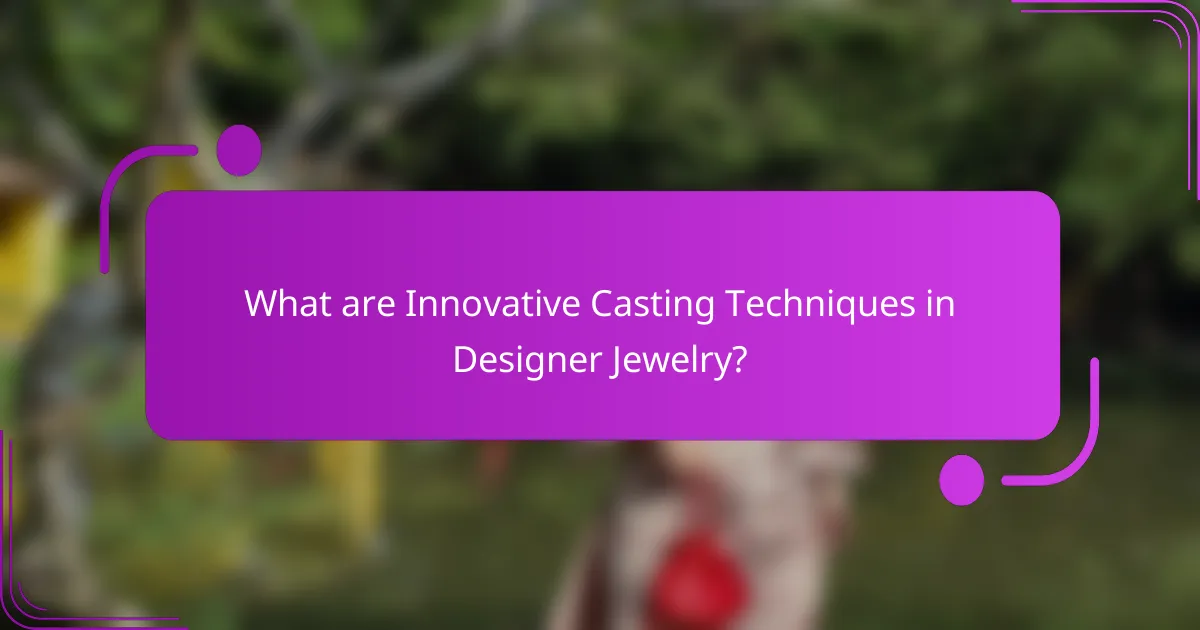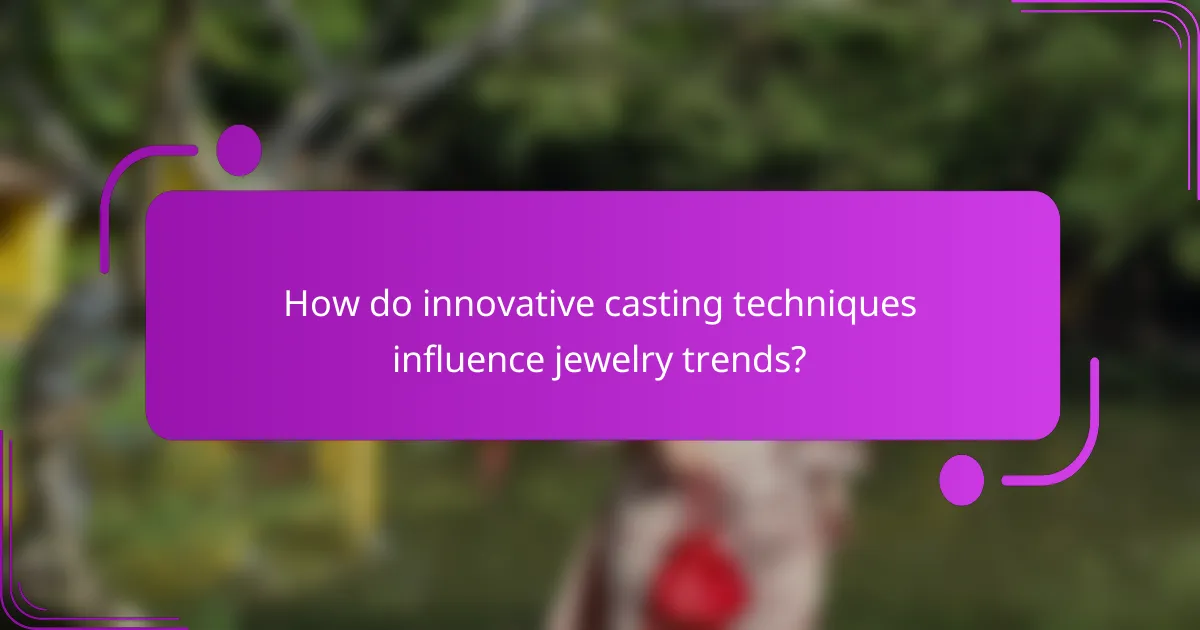Innovative casting techniques in designer jewelry encompass methods such as lost-wax casting, 3D printing, and investment casting, each offering unique advantages for creating intricate and customized designs. Lost-wax casting allows for high detail through the melting of a wax model, while 3D printing facilitates rapid prototyping and complex shapes that traditional techniques cannot achieve. Investment casting employs a ceramic shell for precise molds, ensuring quality in fine jewelry production. The article details the steps involved in these casting processes, including pattern creation, mold making, and finishing, highlighting how these techniques influence jewelry trends by enhancing design possibilities and aligning with sustainability initiatives. Overall, the innovative casting methods significantly impact both the aesthetic and functional aspects of contemporary jewelry.

What are Innovative Casting Techniques in Designer Jewelry?
Innovative casting techniques in designer jewelry include methods such as lost-wax casting, 3D printing, and investment casting. Lost-wax casting allows for intricate designs by creating a wax model that is melted away. This method has been used for centuries and enables high detail in metal forms. 3D printing technology offers rapid prototyping and customization options. It allows designers to create complex shapes that would be difficult to achieve with traditional methods. Investment casting uses a ceramic shell to create precise molds, ideal for fine jewelry. These techniques enhance creativity and efficiency in the jewelry-making process. Each method contributes unique advantages to the design and production of jewelry pieces.
How do innovative casting techniques differ from traditional methods?
Innovative casting techniques differ from traditional methods primarily in their use of technology and materials. Traditional casting often relies on sand or metal molds, which can be less precise. Innovative techniques utilize 3D printing and CNC machining for greater accuracy and design flexibility. For instance, 3D printing allows for intricate designs that are difficult to achieve with traditional methods. Additionally, innovative casting can incorporate new materials like bio-resins and advanced alloys. These materials often provide enhanced durability and aesthetic qualities. Overall, the shift towards technology-driven processes in innovative casting leads to higher efficiency and creativity in designer jewelry.
What specific innovations have emerged in casting techniques?
Innovations in casting techniques include 3D printing, lost-wax casting advancements, and investment casting improvements. 3D printing allows for rapid prototyping and complex designs that traditional methods cannot achieve. Lost-wax casting has seen enhanced precision and reduced material waste through modern technologies. Investment casting has improved with new alloys and casting processes, resulting in better surface finishes and durability. These advancements enable designers to create intricate jewelry pieces more efficiently and with higher quality.
How do these innovations impact the design process?
Innovations in casting techniques significantly enhance the design process in jewelry making. They allow for greater precision and detail in designs. Techniques such as 3D printing and lost-wax casting enable complex shapes that traditional methods cannot achieve. These innovations reduce production time and costs, making it easier for designers to experiment. They also facilitate customization, allowing designers to create unique pieces tailored to individual client preferences. Advanced materials, like resin and metal composites, expand creative possibilities. Ultimately, these innovations transform the design process by enabling more intricate and personalized jewelry creations.
What advantages do innovative casting techniques provide?
Innovative casting techniques provide enhanced precision and design flexibility in jewelry creation. These methods allow for intricate details that traditional techniques often cannot achieve. For instance, 3D printing in casting enables the production of complex shapes without the need for extensive tooling. Additionally, these techniques reduce material waste, as they often utilize less metal than conventional methods. The use of advanced materials in casting can also improve the durability and finish of the final product. Overall, innovative casting techniques streamline the production process and elevate design possibilities in designer jewelry.
How do these techniques enhance the quality of designer jewelry?
Innovative casting techniques enhance the quality of designer jewelry by improving precision and detail. These techniques allow for intricate designs that traditional methods cannot achieve. Advanced technologies like 3D printing enable the creation of complex shapes and patterns. This results in unique pieces that stand out in the market. Additionally, these methods reduce material waste, making production more sustainable. Enhanced quality also comes from better surface finishes, which improve the overall aesthetic. Techniques such as lost-wax casting provide high accuracy in replicating designs. Overall, these innovations contribute to the durability and longevity of the jewelry.
In what ways do they contribute to sustainability in jewelry making?
Innovative casting techniques contribute to sustainability in jewelry making by reducing waste and energy consumption. These methods often utilize recycled materials, minimizing the need for new raw resources. Techniques such as 3D printing allow for precise designs, which lowers excess material use. Additionally, some casting processes require less energy compared to traditional methods. For instance, lost-wax casting can be optimized to improve efficiency. Sustainable materials like lab-grown gemstones are increasingly incorporated, further enhancing eco-friendliness. By adopting these innovative techniques, the jewelry industry can significantly lower its environmental impact.
What materials are commonly used in innovative casting techniques?
Innovative casting techniques commonly use materials such as resin, silicone, and various metals. Resin is favored for its versatility and ability to capture intricate details. Silicone molds allow for easy reproduction of designs and are reusable. Metals like gold, silver, and bronze are traditional choices for their durability and aesthetic appeal. Additionally, newer materials such as 3D-printed plastics are gaining popularity for their customizability and rapid prototyping capabilities. These materials enhance the creative possibilities in designer jewelry.
What are the benefits of using specific metals and alloys?
Specific metals and alloys offer several benefits in jewelry design. They provide durability, resistance to corrosion, and aesthetic appeal. For instance, gold alloys enhance strength while maintaining luster. Silver alloys improve tarnish resistance, ensuring longer-lasting beauty. Additionally, specific metals like titanium are lightweight yet strong, ideal for intricate designs. Alloys can also be tailored for specific properties, such as hypoallergenic qualities. This versatility allows designers to create unique pieces that meet both functional and aesthetic needs. The use of metals and alloys in jewelry ensures longevity and satisfaction for consumers.
How do different materials affect the final appearance of jewelry?
Different materials significantly influence the final appearance of jewelry. Each material has unique properties that affect color, texture, and shine. For instance, gold offers a warm, rich hue and a high luster. Silver provides a bright, reflective surface but may tarnish over time. Gemstones add vibrant colors and can vary in clarity and cut, impacting their visual appeal. Additionally, materials like resin can create a modern, sleek finish. The choice of material also affects weight and durability, influencing how the piece is worn. Ultimately, the selection of materials plays a crucial role in defining the aesthetic and overall quality of jewelry pieces.

What are the steps involved in the innovative casting process?
The steps involved in the innovative casting process include pattern creation, mold making, metal preparation, pouring, and finishing. First, designers create a pattern, often using CAD software for precision. Next, a mold is made, typically from silicone or other flexible materials. After the mold is prepared, the metal is melted to the required temperature for casting. The molten metal is then poured into the mold, allowing it to take shape. Finally, once cooled, the piece undergoes finishing processes, which may include polishing and surface treatments. Each of these steps is crucial to ensure high-quality results in designer jewelry.
How is the design prepared for the casting process?
The design is prepared for the casting process through several key steps. Initially, a detailed blueprint or digital model is created. This design specifies dimensions, shapes, and intricate details. Next, a prototype is often produced using 3D printing or wax modeling. The prototype allows for adjustments before finalizing the design. Once approved, the prototype is used to create a mold. Molds can be made from materials like silicone or metal. The mold captures the design’s details accurately. Finally, the mold is prepared for casting by ensuring it is clean and free of debris. This preparation is crucial for achieving a high-quality final product.
What role does technology play in the design phase?
Technology plays a crucial role in the design phase of innovative casting techniques in designer jewelry. It enables designers to create intricate and precise models using computer-aided design (CAD) software. CAD allows for rapid prototyping and visualization of designs before production. Additionally, 3D printing technology facilitates the creation of complex shapes that traditional methods cannot achieve. This technology reduces material waste and speeds up the overall design process. Furthermore, advanced simulation tools help predict how materials will behave during casting. These capabilities lead to higher quality and more innovative jewelry pieces. The integration of technology in design enhances creativity while ensuring efficiency and accuracy in the final product.
How are molds created for casting?
Molds for casting are created through various methods, including sand casting, investment casting, and 3D printing. In sand casting, a pattern is placed in sand to create a mold cavity. Investment casting involves coating a wax pattern with a ceramic shell, which is then heated to remove the wax. 3D printing allows for the direct creation of complex molds from digital designs. Each method has specific applications and benefits, such as precision and the ability to create intricate designs. The choice of method depends on the desired characteristics of the final cast piece.
What are the casting methods used in designer jewelry?
The casting methods used in designer jewelry include lost-wax casting, sand casting, and investment casting. Lost-wax casting involves creating a wax model, covering it with a ceramic shell, and then melting the wax away to pour molten metal. This method allows for intricate designs and fine details. Sand casting uses a mold made from sand to shape the metal, suitable for larger pieces and less detailed designs. Investment casting, similar to lost-wax, uses a wax model but is more precise, often resulting in smoother finishes. Each method has its unique advantages, catering to different design complexities and material choices.
What is the process of lost-wax casting?
Lost-wax casting is a metal casting process that involves creating a wax model of the desired object. First, the wax model is coated with a ceramic material to form a mold. Once the mold is set, the wax is melted and drained away, leaving a hollow cavity. Next, molten metal is poured into the mold to fill the cavity. After the metal cools and solidifies, the ceramic mold is broken away to reveal the cast object. This technique allows for intricate designs and fine details, making it popular in jewelry making. Historical records indicate that lost-wax casting dates back to ancient civilizations, showcasing its long-standing effectiveness and versatility in crafting detailed metal objects.
How does 3D printing integrate with casting techniques?
3D printing integrates with casting techniques by allowing the creation of precise patterns for casting. This process starts with a digital design that is printed layer by layer using a 3D printer. The printed pattern can be made from materials such as wax or resin. Once the pattern is complete, it is coated with a ceramic shell to create a mold. After the mold is set, the printed pattern is removed, typically through melting or burning. This leaves a hollow cavity in the mold for the molten metal to be poured in. The integration enhances accuracy and reduces lead times in jewelry production. Studies show that 3D printing can reduce pattern-making time by up to 90%.

How do innovative casting techniques influence jewelry trends?
Innovative casting techniques significantly influence jewelry trends by enabling unique designs and enhancing material properties. Techniques such as 3D printing and lost-wax casting allow for intricate patterns and customized shapes. These methods support the creation of lightweight yet durable pieces, appealing to contemporary consumers. Additionally, advancements in materials, like eco-friendly resins and alloys, align with sustainability trends in jewelry. The use of technology in casting also fosters a shift towards personalized jewelry, catering to individual preferences. As a result, innovative casting techniques drive both aesthetic and functional trends in the jewelry industry.
What current trends are emerging in designer jewelry due to these techniques?
Emerging trends in designer jewelry include the use of 3D printing and sustainable materials. 3D printing allows for intricate designs that were previously difficult to achieve. This technology enables rapid prototyping and customization for individual clients. Sustainable materials, such as recycled metals and lab-grown gemstones, are increasingly favored. These materials align with consumer demand for eco-friendly products. Additionally, mixed media designs are gaining popularity, combining traditional metals with unconventional materials. These trends reflect a shift towards personalization and environmental consciousness in the jewelry industry.
How do consumer preferences shape the use of innovative casting?
Consumer preferences significantly influence the use of innovative casting in designer jewelry. As consumers increasingly seek unique and personalized pieces, designers adopt advanced casting techniques to meet these demands. For instance, 3D printing technology allows for intricate designs that traditional methods cannot achieve. This shift towards customization is supported by a report from McKinsey, indicating that 70% of consumers prefer personalized products. Additionally, sustainability preferences lead designers to explore eco-friendly materials and processes in casting. This trend aligns with a study by Nielsen, which found that 73% of millennials are willing to pay more for sustainable offerings. Thus, consumer preferences drive innovation in casting methods, pushing the jewelry industry towards more creative and responsible practices.
What practical tips can be applied when using innovative casting techniques?
Use precise temperature control to ensure proper metal flow. This minimizes defects in the casting process. Employ high-quality molds to enhance detail and finish. This results in better reproduction of intricate designs. Consider using vacuum casting techniques for improved air removal. This reduces the risk of bubbles in the final product. Experiment with different materials for molds to find optimal results. Each material can affect the casting process differently. Always conduct small test casts before full production. This helps identify potential issues early on.
What are common challenges and solutions in the casting process?
Common challenges in the casting process include air bubbles, misalignment, and material shrinkage. Air bubbles can occur when the mold is not properly filled, leading to defects. Solutions involve using vacuum systems to eliminate air during casting. Misalignment can happen if the mold halves do not fit together correctly. This can be resolved by ensuring precise mold design and alignment fixtures. Material shrinkage occurs as metals cool and solidify, potentially causing dimensional inaccuracies. To counteract this, designers can use compensating techniques, such as designing molds with additional material to account for shrinkage.
How can designers maximize the benefits of innovative casting methods?
Designers can maximize the benefits of innovative casting methods by selecting the appropriate materials and techniques. They should evaluate the specific properties of materials like resin, metal, or ceramic for their casting projects. Utilizing advanced technologies such as 3D printing can enhance precision and reduce waste. Implementing efficient mold-making processes can also improve the quality of the final product. Additionally, designers should stay updated on industry trends and innovations to leverage new techniques effectively. Collaborating with skilled artisans can provide insights into optimizing casting methods. Finally, testing prototypes can help identify the best approaches for specific design goals.
Innovative casting techniques in designer jewelry encompass methods such as lost-wax casting, 3D printing, and investment casting, each offering unique advantages in design and production. These techniques enhance precision, reduce material waste, and allow for intricate designs that traditional methods cannot achieve. The article explores how these innovations influence jewelry trends, improve sustainability, and the specific materials used in the casting process. Additionally, it addresses common challenges in casting and provides practical tips for designers to maximize the benefits of these advanced methods.